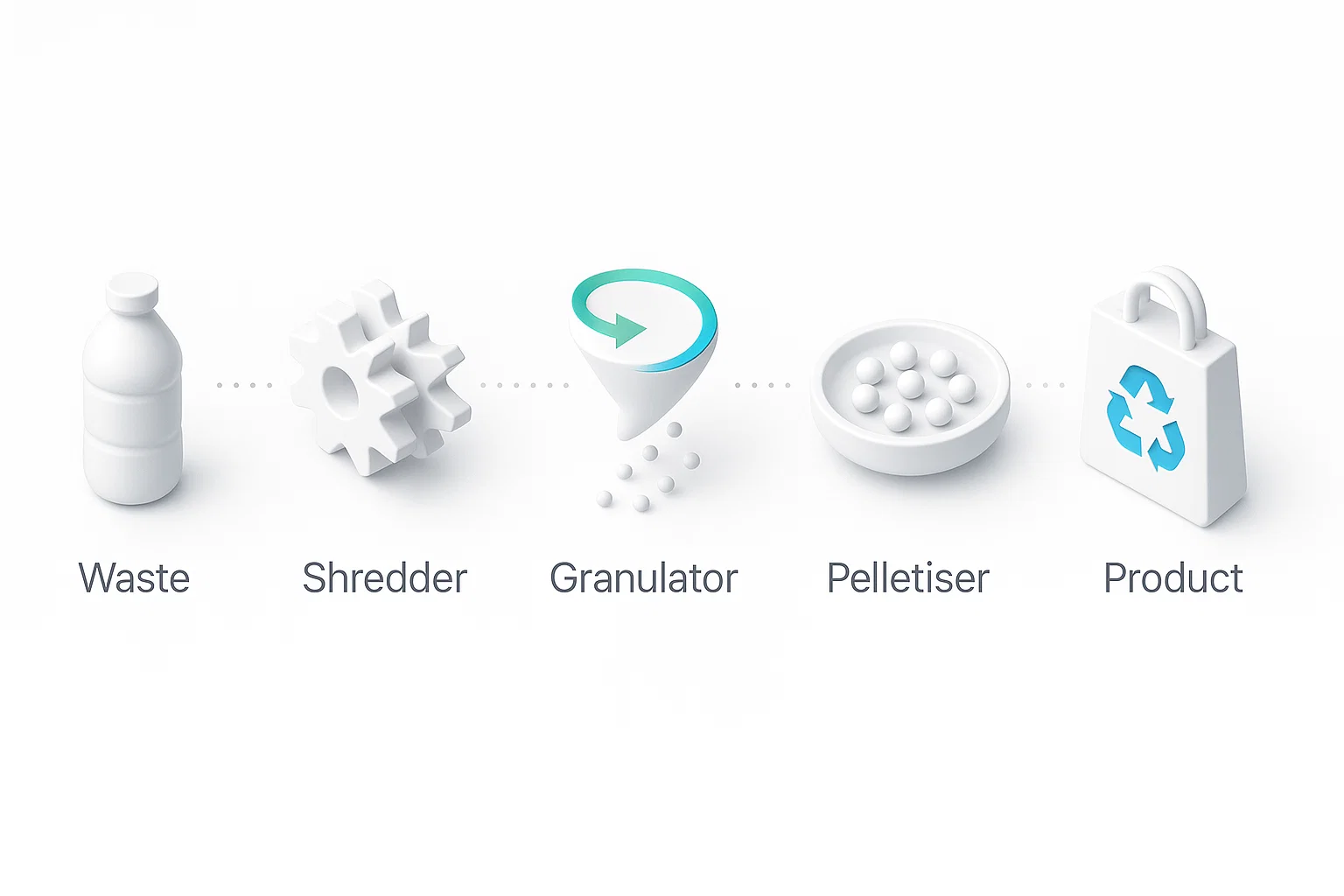Istotna rola granulatorów tworzyw sztucznych w nowoczesnym recyklingu
Maszyny do granulacji plastiku są podstawą każdego skutecznego systemu recyklingu plastiku. Współpracują z innymi specjalistycznymi maszynami, aby przekształcić duże odpady plastikowe w wartościowy, nadający się do ponownego wykorzystania zasób. Zrozumienie ich funkcji jest kluczowe dla docenienia całej podróży recyklingu. Przyjrzyjmy się, w jaki sposób te potężne maszyny wpisują się w kompletne, wydajne rozwiązanie do radzenia sobie z odpadami plastikowymi.
Etap 1: Wstępne przetwarzanie – przygotowanie tworzywa sztucznego do granulacji
Zanim granulator plastiku zacznie działać, surowiec odpadowy musi zostać przygotowany. Ten początkowy etap zazwyczaj obejmuje niszczarka do plastiku.
Dlaczego Shred First? Rozróżnienie niszczarki i granulatora
Często zadawane pytanie brzmi: jaka jest różnica między rozdrabniaczem a granulatorem?
- Niszczarki do plastiku: Są to wolnoobrotowe maszyny o wysokim momencie obrotowym, zaprojektowane do agresywnego rozrywania dużych, ciężkich lub gęstych plastikowych przedmiotów. Pomyśl o nich jako o podstawowej ekipie rozbiórkowej, rozbijającej takie przedmioty jak zderzaki samochodowe, pojemniki na kółkach, rury i duże plastikowe odpady na mniejsze, bardziej szorstkie i łatwiejsze do opanowania kawałki.
- Granulatory tworzyw sztucznych: Są to maszyny o dużej prędkości i niskim momencie obrotowym, które wykorzystują ostre noże w działaniu tnącym przypominającym nożyczki. Biorą wstępnie poszatkowane kawałki plastiku i rozdrabniają je na małe, jednorodne cząstki znane jako „regrind” lub „flakes”.
Użycie rozdrabniacza przed granulatorem spełnia dwa ważne cele:
- Zwiększa wydajność: Znacznie zmniejsza to obciążenie granulatora, dzięki czemu może on pracować o wiele wydajniej.
- Wydłuża żywotność maszyny: Chroni precyzyjne ostrza granulatora przed uszkodzeniem i nadmiernym zużyciem, zapewniając dłuższą żywotność urządzenia.
Etap 2: Granulacja – tworzenie jednolitych płatków plastiku
To jest miejsce, w którym maszyna do granulacji plastiku zajmuje centralne miejsce. Często nazywane kruszarkami plastiku, maszyny te stanowią serce procesu redukcji rozmiaru. Wewnątrz komory tnącej, szybkoobrotowe ostrza pracują przeciwko nieruchomym nożom dolnym, aby pokroić wstępnie pocięty plastik na jednolite płatki.
Wielkość i jakość tego przemiału są kluczowe, ponieważ determinują wydajność kolejnych etapów recyklingu. Nasza oferta Granulatory do plastiku jest zaprojektowany do obsługi szerokiej gamy tworzyw sztucznych, od butelek PET i folii plastikowych po sztywne polimery klasy inżynieryjnej, zapewniając za każdym razem spójne i wysokiej jakości wyniki.
Etap 3: Czyszczenie – Oczyszczanie przemiału
Po zgranulowaniu płatki plastiku muszą zostać dokładnie oczyszczone. Jest to kluczowy krok w celu usunięcia zanieczyszczeń, takich jak brud, etykiety papierowe, kleje i resztki jedzenia, które mogą wpłynąć na jakość końcowego materiału poddanego recyklingowi.
Do tego zadania zazwyczaj stosuje się myjki cierne o dużej prędkości. Jednak w celu usprawnienia i zwiększenia wydajności procesu wiele nowoczesnych zakładów wykorzystuje granulatory do mokrego plastikuTe zaawansowane systemy wprowadzają wodę bezpośrednio do komory tnącej, oferując kilka kluczowych korzyści:
- Jednoczesne czyszczenie: Woda wypłukuje plastik w trakcie jego granulowania.
- Zmniejszone tarcie i ciepło: Woda działa jak środek smarujący i chłodzący, zapobiegając topieniu się miękkich tworzyw sztucznych i wydłużając żywotność ostrzy.
- Tłumienie pyłu: Znacznie minimalizuje ilość pyłu w środowisku przetwarzania.
To zintegrowane podejście gwarantuje czystszy, wyższej jakości przemiał, gotowy do ostatecznej transformacji.
Etap 4: Dalsza obróbka – od płatków do peletów
Po umyciu i wysuszeniu czyste płatki plastiku przechodzą do ostatniego etapu swojej podróży recyklingowej. Zazwyczaj obejmuje to maszyna do granulowania plastikuMaszyna ta topi płatki i wytłacza je przez matrycę, tworząc małe, jednolite granulki (znane również jako „grandles”).
Dlaczego granulki są preferowaną formą? Ich stały rozmiar i kształt sprawiają, że są niezwykle łatwe w obsłudze, transporcie i, co najważniejsze, w dostarczaniu do maszyn produkcyjnych, takich jak wtryskarki i wytłaczarki. Te granulki są surowcem do tworzenia zupełnie nowych produktów z tworzyw sztucznych, zamykając obieg recyklingu.
Kompleksowe rozwiązanie do recyklingu plastiku: jak to wszystko działa razem
Poprzez integrację rozdrabniaczy, granulatorów, systemów mycia i peletyzatorów powstaje bezproblemowa i wysoce efektywna linia recyklingu plastiku. Każda maszyna ma odrębną i istotną rolę.
| Maszyna | Funkcja podstawowa | Wejście | Wyjście |
| Niszczarka do plastiku | Gruba redukcja rozmiarów dużych przedmiotów | Duże części plastikowe, bele | Mniejsze, szorstkie kawałki |
| Granulator plastiku | Drobna redukcja do postaci jednolitych cząstek | Wstępnie poszatkowane kawałki | Małe płatki lub „przemiał” |
| System mycia | Usuwa zanieczyszczenia | Brudne płatki plastiku | Czyste płatki plastiku |
| Granulator plastiku | Tworzy nowy surowiec | Czyste, suche płatki | Jednorodne granulki plastikowe |
Ten zintegrowany system stanowi kompleksowe rozwiązanie, które może obsługiwać wszystko, od opakowań pochodzących od konsumentów, takich jak butelki PET, po sztywne tworzywa sztuczne wykorzystywane w przemyśle.
Często zadawane pytania (FAQ)
P: Czy granulator może samodzielnie przetwarzać duże części plastikowe?
A: Podczas gdy niektóre ciężkie granulatory mogą obsługiwać większe części, ogólnie rzecz biorąc, znacznie bardziej wydajne i ekonomiczne jest użycie rozdrabniacza do początkowej redukcji rozmiaru. Zapobiega to zakleszczaniu, zmniejsza zużycie granulatora i skutkuje bardziej spójnym końcowym rozmiarem cząstek.
P: Czym jest „regrind”?
A: Regrind to termin oznaczający małe, poddane recyklingowi cząstki plastiku produkowane przez granulator. Można je mieszać z nowym plastikiem lub używać samodzielnie do produkcji nowych produktów.
P: Czy granulatory na mokro są zawsze lepsze?
A: W przypadku zanieczyszczonych odpadów pokonsumpcyjnych lub tworzyw sztucznych wrażliwych na ciepło granulatory mokre oferują znaczące korzyści w zakresie czyszczenia i wydajności. W przypadku czystego, wewnętrznego złomu przemysłowego granulator suchy może być całkowicie wystarczający.
Wnioski: Kamień węgielny gospodarki o obiegu zamkniętym
Maszyny do granulacji plastiku to znacznie więcej niż tylko urządzenia do redukcji rozmiaru; są one podstawą sukcesu gospodarki o obiegu zamkniętym. Współpracując z rozdrabniaczami, myjkami i peletyzatorami, stanowią krytyczne ogniwo, które przekształca problematyczne odpady plastikowe w wysokiej jakości materiał nadający się do ponownego użycia. Proces ten nie tylko odwraca uwagę od składowisk i oceanów, ale także zmniejsza naszą zależność od zasobów pierwotnych, torując drogę do bardziej zrównoważonej przyszłości.



